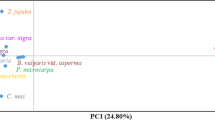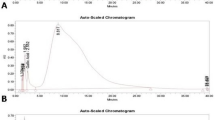Abstract
Mulberry fruit is well recognized as one of the richest sources of bioactive compounds. We investigated the physicochemical composition and characterized the bioactive compounds during different ripening stages of mulberry (Morus indica) fruit and evaluated their anti-quorum sensing activity on Chromobacterium violaceum. The proximate components such as carbohydrates, proteins and lipids were found to be high in the ripe fruit compared to unripe and mid-ripe fruit. The ripe fruit contained higher content of total phenolics and flavonoids (336.05 and 282.55 mg/100 g fresh weight (FW), respectively). Epicatechin and resveratrol were the major polyphenols detected in the fruit with the range 5.13–19.46 and 4.07–14.45 mg/100 g FW, respectively. Chlorogenic acid and myricetin were predominant in the unripe and mid-ripe fruit (7.14 and 1.84 mg/100 g FW, respectively). The fruit was found to be an excellent source of anti-diabetic compound 1-deoxynojirimycin. The highest content of 1-deoxynojirimycin was present in the mid-ripe fruit, with a content of 2.91 mg/100 g FW. Furthermore, fruit extracts exhibited anti-quorum sensing activity against Chromobacterium violaceum by effectively inhibiting violacein production. Ripe fruit extracts showed the highest activity of 76.30% at 1 mg/mL and thus, could be used as a potent anti-quorum sensing agent. The results could be promising in the selection of appropriate developmental stages for M. indica fruit commercial exploitation in the food formulations rich in potential health components.


Similar content being viewed by others
Data Availability
Data is available upon request.
References
Donno D, Cerutti AK, Prgomet I, Mellano MG, Beccaro GL (2015) Foodomics for mulberry fruit (Morus spp.): analytical fingerprint as antioxidants and health properties determination tool. Food Res Int 69:179–188. https://doi.org/10.1016/j.foodres.2014.12.020
Soares LMN, Silva GM, Alonso Buriti FC, Alves HS (2021) Cereus jamacaru D.C. (Mandacaru): a promising native Brazilian fruit as a source of nutrients and bioactives derived from its pulp and skin. Plant Foods Hum Nutr 76:170–178. https://doi.org/10.1007/s11130-021-00885-9
Berru LB, Glorio-Paulet P, Basso C et al (2021) Chemical composition, tocopherol and carotenoid content of seeds from different Andean lupin (Lupinus mutabilis) ecotypes. Plant Foods Hum Nutr 76:98–104. https://doi.org/10.1007/s11130-021-00880-0
Seraglio SKT, Schulz M, Nehring P et al (2018) Nutritional and bioactive potential of Myrtaceae fruits during ripening. Food Chem 239:649–656. https://doi.org/10.1016/j.foodchem.2017.06.118
Lee Y, Hwang KT (2017) Changes in physicochemical properties of mulberry fruits (Morus alba L.) during ripening. Sci Hortic 217:189–196. https://doi.org/10.1016/j.scienta.2017.01.042
Krishna H, Singh D, Singh R, Kumar L, Sharma B, Saroj PL (2018) Morphological and antioxidant characteristics of mulberry (Morus spp.) genotypes. J Saudi Soc Agr Sci 19:136–145. https://doi.org/10.1016/j.jssas.2018.08.002
Jan B, Parveen R, Zahiruddin S, Khan MU, Mohapatra S, Ahmad S (2021) Nutritional constituents of mulberry and their potential applications in food and pharmaceuticals: a review. Saudi J Bio Sci 28:3909–3921. https://doi.org/10.1016/j.sjbs.2021.03.056
Zhang W, Mu W, Wu H, Liang Z (2019) An overview of the biological production of 1-deoxynojirimycin: current status and future perspective. Appl Microbiol Biotechnol 103:9335–9344. https://doi.org/10.1007/s00253-019-10191-9
Ayala-Zavala F, Vega-Vega V, Rosas-Domínguez C et al (2011) Agro-industrial potential of exotic fruit byproducts as a source of food additives. Food Res Int 44:1866–1874. https://doi.org/10.1016/j.foodres.2011.02.021
Kumar SS, Manoj P, Shetty NP, Prakash M, Giridhar P (2015) Characterization of major betalain pigments-gomphrenin, betanin and isobetanin from Basella rubra L. fruit and evaluation of efficacy as a natural colourant in product (ice cream) development. J Food Sci Technol 52:4994–5002. https://doi.org/10.1007/s13197-014-1527-z
Appiah F, Kumah P, Idun I (2011) Effect of ripening stage on composition, sensory qualities and acceptability of keitt mango (Mangifera indica) chips. Afr J Food Agr Nutr Dev 11:5096–5109. https://doi.org/10.4314/ajfand.v11i5.70439
Panche AN, Diwan AD, Chandra SR (2016) Flavonoids: an overview. J Nutr Sci 5:1–15. https://doi.org/10.1017/jns.2016.41
Bhatt ID, Rawat S, Badhani A, Rawal RS (2016) Nutraceutical potential of selected wild edible fruits of the Indian Himalayan region. Food Chem 215:84–91. https://doi.org/10.1016/j.foodchem.2016.07.143
Mahmood T, Anwar F, Abbas M, Saari N (2012) Effect of maturity on phenolics (phenolic acids and flavonoids) profile of strawberry cultivars and mulberry species from Pakistan. Int J Mol Sci 13:4591–4607. https://doi.org/10.3390/ijms13044591
Del Bo C, Bernardi S, Marino M et al (2019) Systematic review on polyphenol intake and health outcomes: is there sufficient evidence to define a health-promoting polyphenol-rich dietary pattern? Nutrients 11:1355. https://doi.org/10.3390/nu11061355
Nazareth MS, Shreelakshmi SV, Shetty NP (2021) Identification and characterization of polyphenols from Carissa spinarum fruit and evaluation of their antioxidant and anti-quorum sensing activity. Curr Microbiol 78:1277–1285. https://doi.org/10.1007/s00284-021-02381-4
Belwal T, Pandey A, Bhatt ID, Rawal RS, Luo Z (2019) Trends of polyphenolics and anthocyanins accumulation along ripening stages of wild edible fruits of Indian Himalayan region. Sci Rep 9:1–11. https://doi.org/10.1038/s41598-019-42270-2
Abdulkhaleq LA, Assi MA, Noor M, Abdullah R, Saad MZ, Taufiq-Yap YH (2017) Therapeutic uses of epicatechin in diabetes and cancer. Vet World 10:869–872. https://doi.org/10.14202/vetworld.2017.869-872
Hussain K, Ismail Z, Sadikun A, Ibrahim P (2009) Evaluation of metabolic changes in fruit of Piper sarmentosum in various seasons by metabolomics using fourier transform infrared (FTIR) spectroscopy. Int J Pharm Clin Res 1:68–71
Zhang J, Wang X, Yu O et al (2011) Metabolic profiling of strawberry (Fragaria x ananassa Duch.) during fruit development and maturation. J Exp Bot 62:1103–1118. https://doi.org/10.1093/jxb/erq343
Asano N (2003) Glycosidase inhibitors: update and perspectives on practical use. Glycobiology 13:93–104. https://doi.org/10.1093/glycob/cwg090
Yoshihashi T, Do HT, Tungtrakul P, Boonbumrung S, Yamaki K (2010) Simple, selective, and rapid quantification of 1-deoxynojirimycin in mulberry leaf products by high-performance anion-exchange chromatography with pulsed amperometric detection. J Food Sci 75:246–250. https://doi.org/10.1111/j.1750-3841.2010.01528.x
Sebastia N, Montoro A, Leon Z, Soriano JM (2017) Searching trans-resveratrol in fruits and vegetables: a preliminary screening. J Food Sci Technol 54:842–845. https://doi.org/10.1007/s13197-016-2474-7
Shrikanta A, Kumar A, Govindaswamy V (2015) Resveratrol content and antioxidant properties of underutilized fruits. J Food Sci Technol 52:383–390. https://doi.org/10.1007/s13197-013-0993-z
Wang SY, Chen CT, Wang CY, Chen P (2007) Resveratrol content in strawberry fruit is affected by preharvest conditions. J Agric Food Chem 55:8269–8274. https://doi.org/10.1021/jf071749x
Jeandet P, Bessis R, Sbaghi M, Meunier P (1995) Production of the phytoalexin resveratrol by grapes as a response to Botrytis attack under natural conditions. J Phytopathol 143:135–139. https://doi.org/10.1111/j.1439-0434.1995.tb00246.x
Lee DU, Kim HM, Lee DG, Jeon SH, Lee JJ, Lee S (2014) Effects of thermal treatments on the stability of trans-resveratrol and yeast inactivation in trans-resveratrol-amplified grape juice. Arch Biol Sci 66:323–329. https://doi.org/10.2298/ABS1401323L
Alvarez MV, Moreira MR, Ponce A (2012) Antiquorum sensing and antimicrobial activity of natural agents with potential use in food. J Food Saf 32:379–387. https://doi.org/10.1111/j.1745-4565.2012.00390.x
Gopu V, Kothandapani S, Shetty PH (2015) Quorum quenching activity of Syzygium cumini (L.) skeels and its anthocyanin malvidin against Klebsiella pneumoniae. Microb Pathog 79:61–69. https://doi.org/10.1016/j.micpath.2015.01.010
Acknowledgements
The authors are thankful to the SERB-DST (SERB/MOFPI/0012/2014), Government of India, New Delhi for their financial assistance. We greatly acknowledge the Director, CSIR-CFTRI, for kind support.
Author information
Authors and Affiliations
Corresponding author
Ethics declarations
Conflict of Interest
The authors declare that they have no conflicts of interest.
Human and Animal Participants
This article does not contain any studies with human or animal subjects.
Additional information
Publisher's Note
Springer Nature remains neutral with regard to jurisdictional claims in published maps and institutional affiliations.
Supplementary Information
Below is the link to the electronic supplementary material.
Rights and permissions
About this article
Cite this article
Shreelakshmi, S.V., Nazareth, M.S., Kumar, S.S. et al. Physicochemical Composition and Characterization of Bioactive Compounds of Mulberry (Morus indica L.) Fruit During Ontogeny. Plant Foods Hum Nutr 76, 304–310 (2021). https://doi.org/10.1007/s11130-021-00909-4
Accepted:
Published:
Issue Date:
DOI: https://doi.org/10.1007/s11130-021-00909-4




